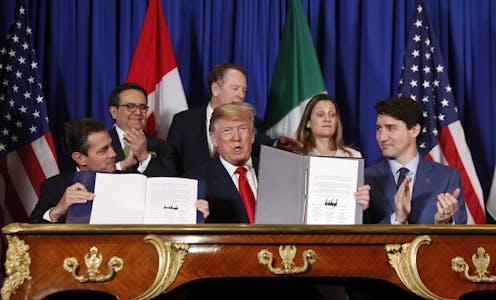USMCA: The 3 most important changes in the new NAFTA and why they matter
President Trump and Democrats recently agreed on a deal to pass the U.S.-Mexico-Canada Agreement. A trade scholar explains what's new.

President Donald Trump and Democratic leaders agreed on a deal to pass a new trade agreement between the U.S., Mexico and Canada that will update NAFTA.
Passing the new trade accord, known as the U.S.-Mexico-Canada Agreement, would be a substantial win for both Trump – given it’s one of his campaign promises – and Democrats, who want to show they’re legislating even as they prepare to impeach the president.
So how is the USMCA different from the North American Free Trade Agreement, and why should you care?
Although the final revised text of the USMCA has not yet been released, the deal as detailed in May contains numerous tweaks from its predecessor, both big and small. As an agriculture economist who studies trade, I believe three changes are especially noteworthy.
Please pass the butter
Since 1994, the U.S. and Canada have dropped tariffs and other trade restrictions on most agricultural products. But there were a few exceptions, most notably dairy.
Dairy was a particularly problematic sticking point in year-long negotiations between the three countries. The U.S. and Canada both have long histories of protectionist policies, such as subsidizing dairy farmers and setting import quotas on milk. Canadian tariffs on some products can be as high as 300%.
The new USMCA begins to change that, representing a small but important win for both countries, especially the U.S.
Under the new accord, Canada will curb some of the ways it protects its dairy industry, such as allowing more American milk, butter, cheese and other dairy products to enter Canada duty-free, with reciprocal treatment for Canadian dairy exports to the U.S.
Made in North America
The new agreement also made big changes for auto manufacturers in hopes of ensuring more vehicles and parts are made in North America.
Starting as early as 2020, to qualify for zero tariffs when crossing borders, a car or truck must have 75% of its components manufactured in Canada, the U.S. or Mexico, up from 62.5% currently.
Even more noteworthy, negotiators agreed to a new requirement that 40% to 45% of a vehicle’s components must be made by workers earning at least US$16 per hour, which is about three times more than the average wage currently earned by Mexican auto workers.
This change is huge, particularly for low-paid workers in Mexico. But it may lead to challenges over the enforcement of labor laws and increase the cost of cars made in all three countries.
Keeping up with the times
Society has experienced significant technological changes since NAFTA was implemented in 1994. Back then, the internet was still in its infancy, while smartphones and self-driving cars were barely imaginable.
That’s why modernization – updating rules and standards to keep up with the times – is a critical and positive update to the trade deal tying the North American continent together.
While NAFTA was the first trade treaty to include intellectual property protections, the high pace of innovation has made modernization of its provisions imperative.
The new agreement includes stronger protections for patents and trademarks in areas such as biotech, financial services and domain names – all of which have advanced considerably over the past quarter-century. It also contains new provisions governing the expansion of digital trade and investment in innovative products and services.
Separately, negotiators agreed to update labor and environmental standards, which were not central to the 1994 accord and are now typical in modern trade agreements. Examples include enforcing a minimum wage for autoworkers, stricter environmental standards for Mexican trucks and new rules on fishing to protect marine life.
Apart from the changes, there is one important thing about the original NAFTA that will stay, thanks to the insistence of Canada. Chapter 19 is the dispute settlement mechanism that allows countries to seek remedies for breaking the rules. It’s like “trade court” and makes it much easier to challenge another country’s policies.
Although Mexico’s Senate ratified the USMCA earlier this year, the deal still needed approval from Canada and the U.S. Congress. Democrats and labor unions insisted on revisions to the text to address enforcement of labor and environmental provisions and intellectual property protection. The newly revised text agreed to by Trump and the Democrats addresses these issues and is now ready for approval by all three countries.
All in all, I believe the new NAFTA is definitely a modern and updated version of its important predecessor, which the U.S. Department of Agriculture characterized as one of the most successful trade agreements in history.
This is an updated version of an article originally published on Oct. 2, 2018.
[ Like what you’ve read? Want more? Sign up for The Conversation’s daily newsletter. ]
Amanda M. Countryman receives funding from the National Science Foundation and the U.S. Department of Agriculture.
Read These Next
The ‘one chatbot per child’ model for AI in classrooms conflicts with what research shows: Learning
AI tutors are often held up as an ideal, but prioritizing individualized teaching can detract from the…
How the NIH became the backbone of American medical research and a major driver of innovation and ec
The agency’s budget has grown steadily since the 1960s, fueling an industry that creates lifesaving…
Best way for employers to support employees with chronic mental illness is by offering flexibility
Employers that don’t support employees with mental illness risk missing out on the talents and skills…





